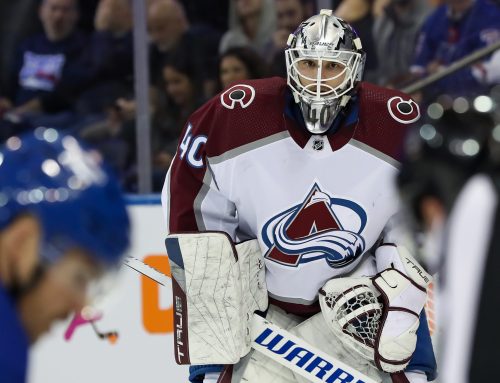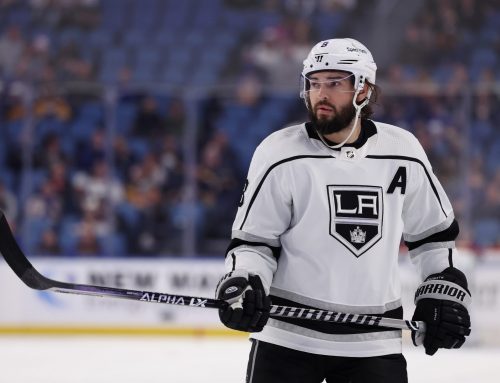It’s All in the Numbers Part 1 (West 2012)
Ryan Ma
2012-01-10

I'm sure you've heard of the phrase "the numbers don't lie". If you're a dedicated follower of my columns here at DobberHockey, then you're probably well aware of how much I utilize stats to inform me during my decision-making process. For the past couple of seasons, I've been tracking baseline values into forecasting future stats. This week we'll take a look at those values to help us better plan for the rest of this fantasy season.
First, let’s clear up some general misconceptions about projections. Here are 10 of Ma's Laws for the second half:
1) First of all we need to place a realistic value on overall point production.
|
Year |
# of point-per-game players |
# of players > than 80 points |
|
2007-08 |
23 |
19 |
|
2008-09 |
20 |
17 |
|
2009-10 |
21 |
17 |
|
2010-11 |
15* |
9 |
|
2011-12 |
15** |
17** |
*includes Sidney Crosby and Derek Roy
** does not include Crosby
So, just by looking at the table above, realistically there's roughly 20 or so players that will finish at a point-per-game pace, and probably around 17-19 that will tally more than 80 points. If you break it down to a standard 12-team league, that's roughly one, maybe two, per team. If you're expecting three or four, you either have one hell of a team or you're dreaming.
2) Ice-time plays a huge factor in point production.
Of the nine players that hit the 80-point plateau last season, all of them are essentially top-line and top-PP "household" names. As a group they averaged 20:07 overall and 3:52 with the man advantage per contest, so unless they're remotely close to those numbers, don't expect miracles.

3) SOG also plays a large factor in point production especially with defenseman.
Of the nine players that hit the 80-point plateau last season, only one (Henrik Sedin), averaged less than 200 SOG. Out of the top-30 in point production, only two more players (Ryan Getzlaf and Alex Tanguay), notched less than 150 SOG. So if you're after point production, then pay attention to a player's SOG.

4) The number of points that a player tallies is directly linked to how offensive their team is. Below is a table of a player's contribution as a percentage of team production in regards to his scoring position of their team.
|
Position on Team |
Average % of team points |
Max |
Min |
|
1st |
11.47538 |
14.89362 |
8.333333 |
|
2nd |
10.11953 |
13.98601 |
7.575758 |
|
3rd |
9.028225 |
12.01354 |
7.272727 |
|
4th |
8.284656 |
11.42285 |
6.802721 |
|
5th |
7.438827 |
10.33435 |
5.943536 |
|
6th |
6.599186 |
8.115942 |
5.335628 |
|
7th |
5.981781 |
7.401033 |
4.397394 |
|
8th |
5.310378 |
7.401033 |
3.745928 |
|
9th |
4.735752 |
6.071429 |
3.745928 |
|
10th |
4.418149 |
5.742297 |
3.191489 |
The Bruins have accrued 369 points so far this season. If you look at Tyler Seguin, who's leading the team in scoring, he should contribute roughly 11.5 percent of that offense, which works out to be 42 points, which isn't too far off from the 37 that he's currently possesses.
A second way you can use this table is as a predictor. The Avs have 293 points as a team 43 games into the season. If you pro-rate that (assuming they stay on course), over an 82-game season, you'd end up with 558 points. If you predict that Paul Stastny finishes first or second in team scoring, you'll probably look at him tallying somewhere around 10.5 percent of the team's total points, which would be 58 points. If you take that away from the 22 that he currently has, it'd give him 36 points in the remaining 39.
5) The Eastern Conference teams are the slightly more offensive of the two conferences.
The Western Conference teams average 2.63 goals per contest, while their Eastern counterparts average 2.71.
If you have a comparison between two players in a similar point range, choosing the player in the Eastern Conference might give you a slight point advantage a Western Conference counterpart.
|
Western Conference Buys |
Eastern Conference Buys |
|
Red Wings Canucks Blackhawks Sharks
|
Bruins Flyers Leafs
📢 advertisement:
Senators Penguins Devils* |
|
Western Conference Holds |
Eastern Conference Holds |
|
Stars Oilers Predators Blues |
Rangers Capitals Lightning Jets Canadiens |
|
Western Conference Sells |
Eastern Conference Sells |
|
Coyotes Avalanche Flames Blue Jackets Wild Kings |
Hurricanes Sabres Panthers Islanders |
6) Beware of lofty expectations from rookies.
|
Year |
# of rookies > 45 points |
# of rookies > 50 points |
# of rookies > 60 points |
|
2007-08 |
6 |
4 |
2 |
|
2008-09 |
7 |
2 |
0 |
|
2009-10 |
3 |
2 |
0 |
|
2010-11 |
5 |
3 |
1 |
|
2011-12 |
5 |
2 |
2 |
Since 2007, there have only been three rookies (Patrick Kane, Nicklas Backstrom and Jeff Skinner), that have tallied above the 60 point plateau. So the "new NHL" is trending towards a lowered rookie production than that seen during the days of Sidney Crosby and Alex Ovechkin.
With that said, two more could be added to the list if Ryan Nugent-Hopkins (depending on his shoulder injury), and Adam Henrique continue their roles on their respective clubs.
7) Be wary of the second-half of the "magical fourth year" players
( ) current point pace.
*notable injuries
[ ] pro-rated 82-game injured pace
Claude Giroux – 27, 47, 76, (104)
Steven Stamkos – 46, 95, 91, (92)
James Neal – 37, 55, 45, (73*)
Blake Wheeler – 45, 38, 44, (62)
T.J. Oshie – 39, 48, 34* [56], (57)
Jake Voracek – 38, 50, 46, (53)
Kyle Okposo – 39, 52, 20* [43], (37)
Patrick Berglund – 47, 26, 52, (36)
Patrick Hornqvist – 7, 51, 48, (36)
Lauri Korpikoski – 14, 11, 40, (35)
Chris Stewart – 19, 64, 53, (33)
Cal Clutterbuck – 18, 21, 34, (32)
Nikolai Kulemin – 31, 36, 57, (32)
Second half numbers during the "magical fourth year" of recent fourth year breakouts: Mike Richards 1.03, Ryan Getzlaf 1.06, Pavel Datsyuk 1.17, Zach Parise 1.11, Ilya Kovalchuk 1.08, Jeff Carter 0.92, Mike Cammalleri 1.19, Anze Kopitar 1.02, and Paul Stastny 1.02.
Second half numbers point per game numbers of notable "magical fourth year" players from last campaign. Bobby Ryan (1.08), Patrick Kane (1.07), Jonathan Toews (1.00), Sergei Kostitsyn (0.77), Nicklas Backstrom (0.76), Derick Brassard (0.66), Brandon Dubinsky (0.59), Tobias Enstrom (0.57), Sam Gagner (0.58) and Kris Versteeg (0.44).
8) Take advantage of split stats
Some common split stats:
- first half vs. second half
- home games vs. away games
- monthly breakdowns
- Daily breakdowns
- points vs. division, points vs. conference
- even-strength vs. power-play points
For example, Jason Pominville averages 1.17 points-per-game at home compared to 0.88 on the road. On the flip side, Jonathan Toews averages 1.56 on the road compared to 0.73 at home. Second example, 57.5 percent of Brian Campbell's points have come from the league's 12th ranked power-play. If that PP begins to slump, his points will struggle.
9) Take advantage of key injuries to the top-six
Look for players who have increased in ice-time/SOG after a big injury to their team's top-six.
For example, Michal Handzus went from averaging just 35 seconds on the PP to averaging 2:23 since Martin Havlat's hamstring injury. Another example, since Ryan Nugent-Hopkins' injury, Sam Gagner has bumped his average ice-time up to 20:11 (2:45 on the PP), in the last three contests.
10) Take advantage of games played
Due to the disparity in scheduling, there are noticeable differences in games played throughout the league. If you swap out any Sens, Flames, Avs or Canes for Sharks or Bruins, you'd gain an extra five games worth of starts, which could be the difference between winning and losing a league championship come April.
Next week, we’ll look at the real mathematical stuff!
Hopefully you can use the guidelines and numbers above to help you gain a better grasp of what to expect for player X moving forward. Now use this information and create changes to win yourself a fantasy championship. Of course if you are desperately seeking different opinions, hop onto the DobberHockey forums where there are plenty of fantasy fanatics who are ready to give you their opinions. Questions or comments? As always I'll discuss them in the section below.
If you're wondering who the players that the coloured dots in the graphs above represent, you can pop onto my Twitter page to find out. Should you be so inclined, follow me on Twitter if you think that my article/posts are useful.





 NYI
NYI PIT
PIT T.B
T.B TOR
TOR DAL
DAL STL
STL ARI
ARI EDM
EDM MTL
MTL DET
DET WSH
WSH CBJ
CBJ S.J
S.J
